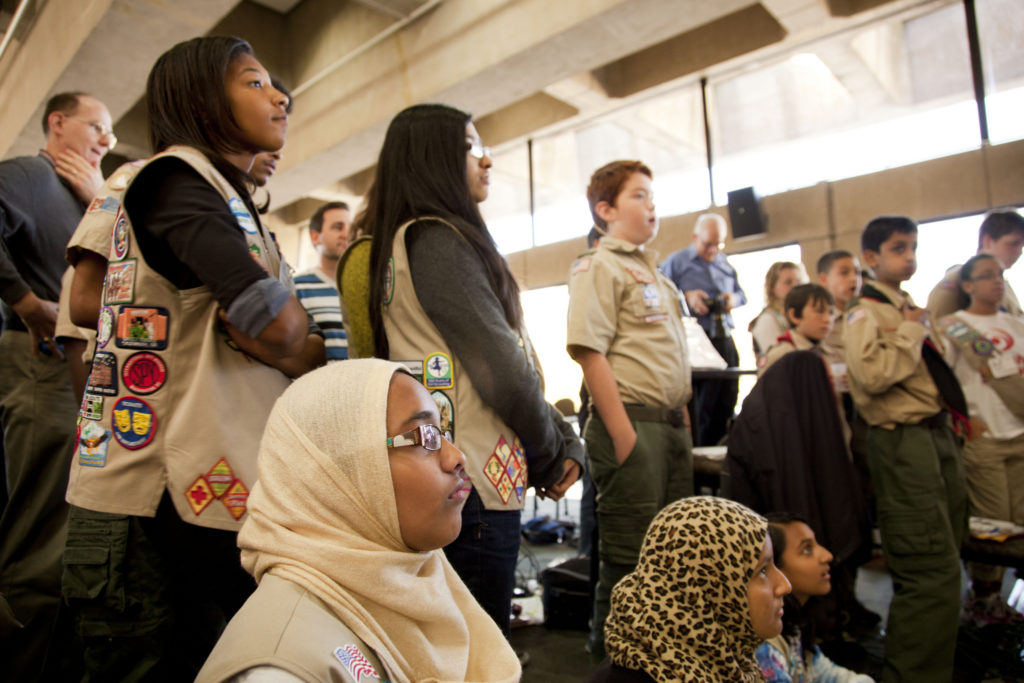Girl Scouts

Photo: Matt Green/U.S. Department of Energy
The UCC Scouting Workgroup is currently comprised of volunteers who have extensive experience with the Boy Scouts, and thus the committee is primarily focused on Scouting as it relates to the BSA. However, we would welcome the opportunity to expand our focus into the Girl Scouts of the USA as well. In order to do so, we would need volunteers with experience in the Girl Scouts program to reach out to us to join our committee.
In the meantime, please see below for basic information on Girl Scouting.
Program Basics
The Girl Scouts have six different age-appropriate programs for girls from kindergarten through high school. It’s broken up as follows:
-
Daisies: Kindergarten & 1st grade
-
Brownies: 2nd & 3rd grade
-
Juniors: 4th & 5th grade
-
Cadettes: 6th, 7th, & 8th grade
-
Seniors: 9th & 10th grade
-
Ambassadors: 11th & 12th grade
The organization of these programs is much different than what you might expect if you only have experience working with the Boy Scouts. Like the Boy Scouts, Girl Scouts operate as members of a troop. However, Girl Scout troops might consist of one age level, or many. Some have only Brownies, for instance, while others might have everything from Daisies up through Ambassadors. Additionally, girls in sixth grade and above can participate on a more individual basis by registering as a “Juliette.” This is similar to the “Lone Scout” option in the Boy Scouts, but more commonly used. Generally, only the younger groups (Daisies, Brownies, and Juniors) are organized into troops. Girl Scout Troops often don’t require as many adult leaders, because much of the administrative functions (typically handled by a unit committee in Boy Scouts) are handled by the local service unit (one or two towns), association (roughly a county), or council (usually much larger than BSA councils).
Girls of every age can earn badges based on a wide range of interests, just like the belt loops, activity pins, and merit badges that can be earned in Cub Scouts and Boy Scouts. There are also “Journeys” that girls can choose to work on during each stage of the program. A journey is an eight to twelve week lesson plan with an overarching theme, which includes earning several badges along the way plus some special Journey badges. These journeys are age-appropriate based on the program level, and each level has an option for each of these three categories: “It’s Your World – Change It!,” “It’s Your Planet – Love It!,” and “It’s Your Story – Tell It!.” Older girls can work towards their Bronze Award (Juniors), Silver Award (Cadets), and Gold Award (Seniors and Ambassadors). These awards require a lot of planning and preparation, and have project components just like the higher ranks of the BSA (including Eagle Scout). Unlike the Boy Scouts, these awards do not have a tenure requirement, but they do require girls to have completed a journey in that program.
Of course, girls of all ages can learn sales, marketing, and personal management skills by selling the ever-popular Girl Scout cookies!
You can find more detailed information on these programs on their website.
Chartered Organizations
Unlike the Boy Scouts, the Girl Scouts of the USA do not operate units under a chartered organization model. Rather than asking community organizations to run the Girl Scout program, the Girl Scouts work to connect leaders with youth and then work with community organizations to find suitable meeting spaces.
If your congregation would like to have a Girl Scout presence to compliment your Boy Scout unit(s), simply contact your local Girl Scout office to ask for more information on how your volunteers can get involved or start a new troop. You can offer your church’s space for the meetings and help provide adult leaders and youth, but you won’t be the “owner” of that unit. The local Girl Scout council is ultimately responsible for the operation of their local troops.
